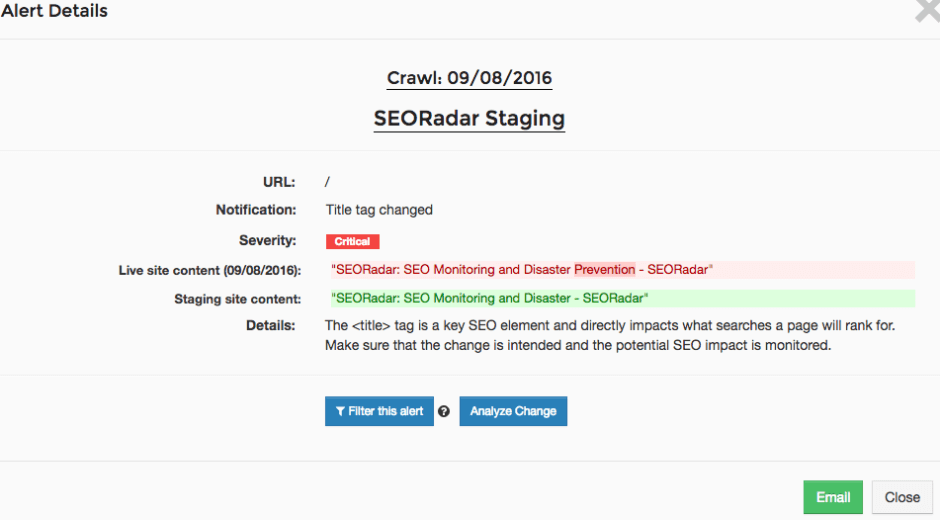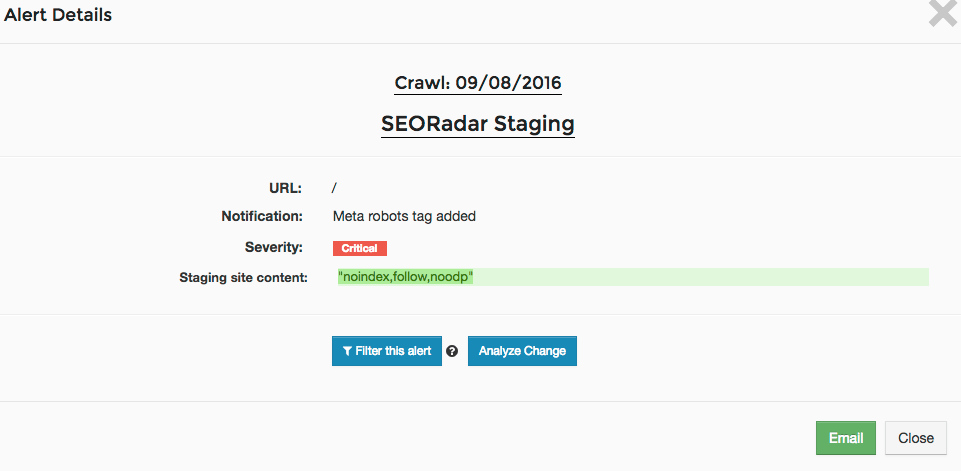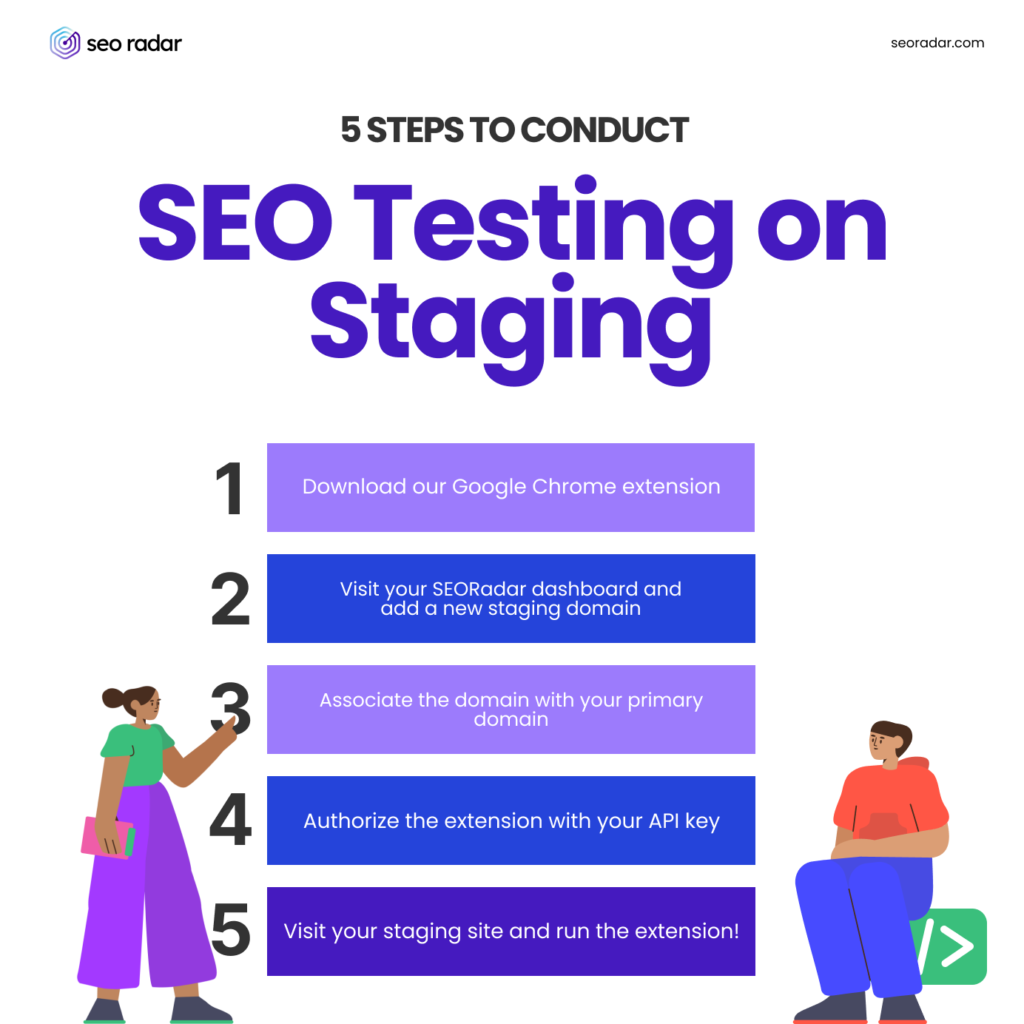SEO Testing on Staging: Catch problems before rankings drop
It’s no news that staging is a vital step in the web development process. A staging website helps teams catch errors before the website goes live. And, for SEO specialists, staging can be an opportunity to detect and prevent coding pitfalls that could hurt the website’s SERP position.
In this page, we’ll explore SEO testing on staging, whether you should do it manually, and how SEORadar can help. Let’s get started with a story from one of our clients.
SEORadar Demo
See how detailed diff monitoring can protect your site and make your life so much easier!
A Needle in a Haystack
A website like Facebook has over 62 million lines of code. It’s highly likely for your company site to have thousands of lines. And if you’re running a directory site, your numbers are probably closer to Facebook’s than you might think.
Combing through your code in search of mislabelled links or harmful metatags is possible. But it’s time-consuming and fallible. Especially because, more often than not, destructive mistakes take the form of tiny snippets that are extremely hard to detect in large codebases.
An SEORadar client found it the hard way after a developer accidentally placed a noindex tag on their key pages. It was just a tiny bit of code, but its impact was tremendous.
The team identified the problem 5 days after the change was made. Due to workflow changes, it took almost a full week to push the fix. Sadly, it was too late. This error caused a 15% decrease in the website’s overall traffic.
If you want to prevent this kind of error, we recommend you take two measures:
- Involve the technical SEO team in your website’s testing process.
- Implement a tool that detects potential issues, even in your staging website.
Let’s take a look at how SEORadar automates SEO testing on staging.
SEO Testing on Staging with SEORadar
SEORadar makes it possible to automatically detect suspicious code changes, even on large websites. When crawling a website for the first time, the tool takes a “snapshot” of your code, which it uses to monitor and automatically detect changes.
When you audit a staging site, SEORadar compares the staging and the live versions, looking for potentially harmful code changes. For example, if the radar suspects that an important keyword has been removed from your title tag, you will get this type of alert:
A change like the one our client reported would have been detected by SEORadar immediately. Of course, his anecdote took place before he met us.
The alert he’d have received would have looked like this:
When we first built this feature, we hit a very common obstacle: We needed VPN access or login credentials to enter staging environments. We understood that granting sensitive credentials to third parties wasn’t a good option, so we found a way around it.
Using our Chrome extension, your browser will retrieve the test pages and send them out to our servers to run the comparisons. No need to open your VPN to us!
Simple & Secure SEO Testing on Staging
In this section, you’ll learn how to conduct automated SEO testing on staging, with our Google Chrome Extension.
In short, here’s how it works:
- Visit your SEORadar dashboard and add a new staging domain.
- Associate the domain with your primary domain
- Authorize the extension with your API key
- Visit your staging site, and run the extension.
Let’s go step-by-step.
Download the SEORadar Crawl & Audit Extension
To get started, visit the Google Chrome web store and download our Crawl & Audit extension. For this process to work, aside from the extension, you’ll need an SEORadar account.
Add the Staging Domain to SEORadar
Once you’ve downloaded the extension, visit your SEORadar dashboard, go to the Domains page, and click on Add Staging Domain. This will take you to a new screen, where you’ll be able to enter the details for your domain.
Associate your staging domain with your primary domain
On the Enter a Live vs Staging Domain page, you will be able to specify your live domain and your staging domain, as well as label your staging domain.
Labeling your staging domain can be useful if you will access it via an IP address or if you have multiple staging environments.
You’ll also be able to finetune some parameters. Should SEORadar ignore your URL query params on comparisons? Should it strip out numerics on text compares? Should it test your robots.txt file? Should it consolidate redirect alerts?
Once you’ve configured your staging domain, it’s time to authorize the extension. This stage is essential for us to connect your extension to your account.
Authorize the extension with your authorization/API key
Visit your User page, and go to Settings.
Under Settings, you’ll find your WordPress/API integration authorization token. Copy the first value and paste it into the extension’s Authorization token field. Click Sign in, and you’re ready to go.
Kick off the crawl from the extension
Finally, visit your staging website and open the extension. Select your staging domain and press Crawl Staging Website. That’s it. SEORadar will test and compare all the URLs that are configured for the live domain.
Catch Problems Before They Go Live
SEORadar is a one-of-a-kind SEO disaster avoidance tool, trusted by some of the largest websites in the world. With SEORadar, you can prevent costly SEO errors before they impact your site. And, if you continue using SEORadar after launch, you will receive automated alerts for new code changes, monitor your competitors’ code, and much more. Start your free trial today.









